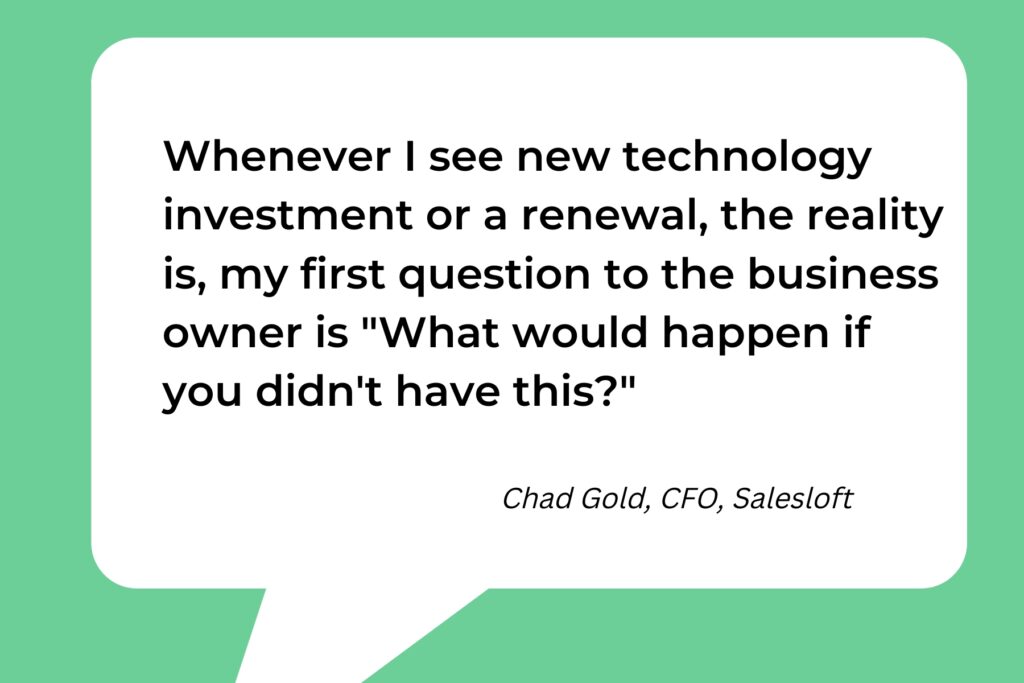With continued tech layoffs and an industry-jolting bank collapse, the growth-at-all-costs era is quickly fading in the rearview mirror. Companies still standing are focused on efficiency across all departments, and you can bet…
… chief financial officers (CFOs) are everywhere in your deals.
When the economy dips, every purchase is scrutinized. In fact, it’s not uncommon for companies to threaten to cancel in order to renegotiate an existing contract. And, even if your budget can cover the purchase of a new tech tool, CFOs will still ask, “What’s the return on investment (ROI) going to be?”
Moving forward, sellers and internal buyers alike must consider the CFO part of the buying group. So, in order to win their approval and move your deal across the finish line, you first need to understand how CFOs think.
CFO Approval Requires These Two Things
CFOs have a unique perspective in that they look at total company expenditures and spending across all departments. Every expense is viewed in the context of a budget cycle.
In a down economy, even if your department has budget dollars to spend, the CFO will need two things to approve a tech purchase: a solid business case and a strong, accountable champion.
#1 Solid Business Case
Having a solid business case means you’re prepared to answer the following questions:
- Do we absolutely need this tech tool?
- Can we do this using our existing systems?
The ROI of any new tech purchase must be tangible with outcome-driven results. Plus, the ROI must include a cost reduction. While it’s great to demonstrate the benefits of driving more revenue or mitigating risk, cost reduction is imperative.
When you sell tech to CFOs, LeanData’s VP of Finance, Larry Cheng, explained, “Expressing ROI in dollars is key. If someone tells me, ‘I’m going to spend $10K on this tool and as a result, we don’t need to hire five people,’ that’s very easy to measure.”
A solid business case also includes an implementation plan. CFOs really care whether a new tool is adopted. Cheng added, “The biggest risk is shelfware. If no one is using a tool, if something is just sitting around, or a tool is not being utilized to its full extent, then I need to allocate those dollars to something else.”
#2 Strong & Accountable Champion
Equally important as the solid business case, any tech purchase needs a strong, accountable champion behind it. That champion is typically the business leader that stands to gain the most from the new tool. It’s not enough to share a one-conversation ROI statistic; this champion needs to own the metrics. CFOs are more willing to work with internal stakeholders who ask for additional budget if the stakeholder has tried to plan the funding themselves.
Building Consensus
Buying decisions, especially involving new technology, are now made on consensus from a buying group that more than likely includes the CFO. It’s no longer a situation where three out of five employees want a particular tool and the majority wins. The buying group now must agree on the problem they are solving for and the goal to be achieved. And, when selling to a group, the group has to be aligned.
In addition, there’s much more fear about making a bad tech purchase. Employees don’t want to step out of balance from the group, leaving them exposed in the next round of layoffs. Sellers can help their buyer-champion by multi-threading and building a coalition.
In the previous growth-at-all-costs market, upsides in revenue took precedence over efficiency. Now it’s flipped. CFOs are less focused on the revenue upside. It’s the efficiencies — the hard cost savings that matter the most. Remember that when you sell tech to CFOs.












